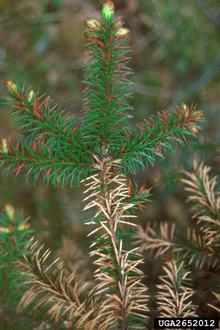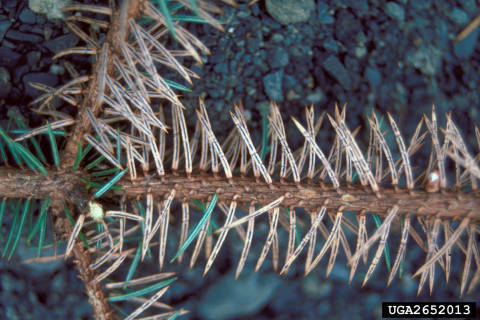Quick facts
- Lirula needle blight causes the inner needles of spruce trees to turn yellow then gray.
- Caused by the fungus Lirula macrospora.
- Occurs in Colorado blue spruce and white spruce.
- White spruce, including Black Hills spruce, is more likely to be damaged.
- Fungicides can be used to protect new needles from infection.
- Do not plant spruce trees where Lirula already occurs.
How to identify Lirula needle blight
Lirula needle blight can infect white spruce (Picea glauca), including Black Hills spruce and Colorado blue spruce (Picea pungens).
- Infected trees have tan to gray needles near the trunk, and green needles on the tips of branches.
- Inner needles first become discolored in late summer, turning from green to yellow and brown.
- In the following year, a raised black line forms along the midrib of infected needles.
- In some cases, horizontal black bands form across infected needles.
- Needles on lower branches are commonly infected first.
- Infected needles turn grayish-brown, but remain attached to the tree for several years.
How does Lirula survive and spread?
It takes several years for Lirula macrospora to complete its life cycle. The fungus overwinters in infected needles on the tree.
During late spring through midsummer, infected needles release spores. These spores spread to new needles by splashing and dripping rain. The infection likely starts on first year needles.
On second year needles, a raised black line forms on the midrib on the underside of the needle. This black line is a spore-producing structure created by the fungus. Spores are released from these structures on third-year needles.
How to manage Lirula needle blight
- Avoid planting spruce where Lirula needle blight already occurs.
- Inspect new seedlings and trees for signs of infection prior to purchase.
- Remove the most heavily infected trees in the landscape to protect neighboring spruce trees.
Fungicides
- Fungicides can be used to protect new needles on trees that are infected with Lirula needle blight and on neighboring spruce trees.
- Apply a fungicide with the active ingredient chlorothalonil or copper sulfate when new needles are half the length of mature needles (typically May or June).
- Make a second application one month later.
- Since the disease cycle is three years long, fungicide application must occur for three consecutive years to be effective.
CAUTION: Mention of a pesticide or use of a pesticide label is for educational purposes only. Always follow the pesticide label directions attached to the pesticide container you are using. Remember, the label is the law.
Reviewed in 2024



